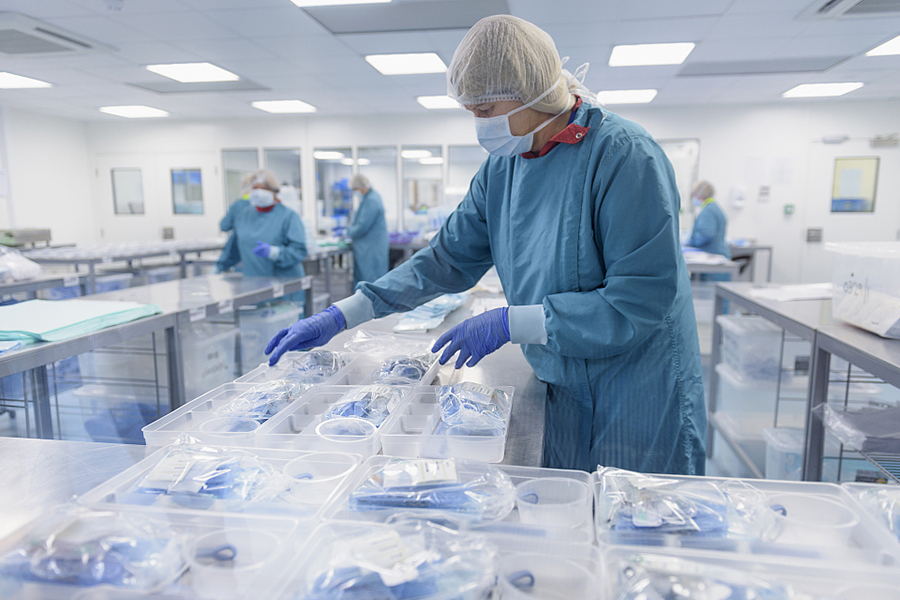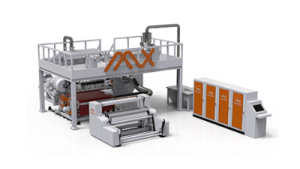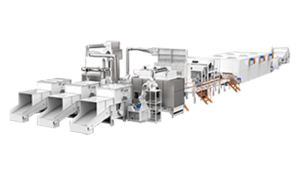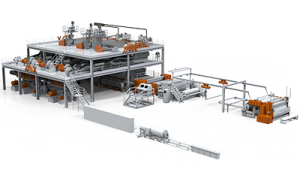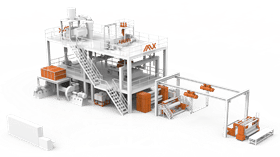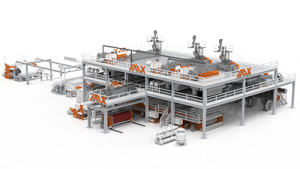The global nonwoven fabric industry is currently facing challenges in the aftermath of the COVID-19 pandemic. The impact of the pandemic on the global spunbond/meltblown polypropylene nonwoven fabric market in 2020 was significant, but demand has now started to normalize, especially for product categories that experienced surges in demand during the peak of the pandemic. It is estimated that the peak demand for masks, protective suits, and wet wipes occurred in mid-2021. Since then, demand for these product categories has slowed, and in early 2023, this slowdown is expected to continue.
In the medical market, some regions have seen an increase in inventory of spunbond rolls and disposable medical products since the third quarter of 2022, as a result of the demand slowdown. Destocking of these medical protective products has begun and is expected to continue through most of 2023.
Additionally, businesses worldwide are facing challenges and uncertainties due to the Russia/Ukraine issue, ongoing inflation, and other potential threats to the global economic system.
Currently, the global spunbond/meltblown polypropylene nonwoven fabric market is in a period of opportunities and challenges. Declining birth rates in most regions, escalating inflation, rising interest rates, and heightened geopolitical tensions could lead to further decreases in global demand.
On the other hand, the nonwoven fabric industry has made significant progress in adopting sustainable raw materials. However, this progress may face headwinds as society’s focus shifts towards war and economic concerns. Despite the uncertainty, as witnessed during the onset and continuation of the COVID-19 pandemic, the nonwoven fabric industry has shown resilience and the ability to successfully navigate challenges.
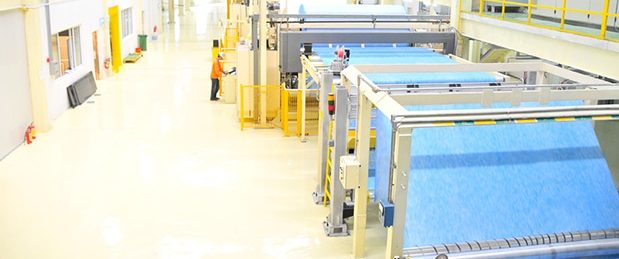
Global Capacity and Demand
In 2022, approximately 239,500 tons of new fine denier capacity were commissioned globally, primarily through Reicofil 5, Fare, and Chinese technologies. These new facilities increased the global total capacity to 5,351.2 thousand tons. This capacity was largely ordered during the most severe period of the pandemic, but with a continuous decline in infection numbers throughout the year, demand steadily decreased. By the end of 2022, capacity utilization had dropped from its mid-2022 peak. An additional 191,000 tons of new fine denier capacity are expected to be commissioned in 2023, bringing the capacity to approximately 5,542.2 thousand tons.
By 2024, an additional 110,000 tons of new capacity are projected to come online, bringing the global fine denier capacity to approximately 5,642.2 thousand tons. Overall, it is estimated that around 541,000 tons of fine denier spunbond capacity will be commissioned between 2022 and 2024, representing an increase of over 10% from 2021, with a compound annual growth rate of 2.7% from 2021 to 2024.
It is anticipated that demand and growth will normalize in 2023, driven by normal demand drivers. In this scenario, low birth rates in nearly all regions will affect the demand for baby diapers. During this period, the annual growth rate in demand for adult incontinence products is expected to be between 5% and 6%.
From 2022 to 2027, the global average annual demand growth is expected to be around 5%. This outlook is sensitive to macroeconomic factors, disease shocks, and global turbulence. The fastest-growing regions in demand will be South Asia (India) and Africa, followed by the Asia-Pacific region and China. Demand growth in North America, South America, Western Europe, and the Middle East regions will be more moderate.
As the full impact of new capacity gradually becomes evident in the market, some regions of the world are expected to face oversupply by 2024. Offset factors for this capacity increase include the possible closure of older technologies that were reactivated during the peak of the pandemic. Raw material costs are expected to remain unstable and disproportionate among regions.
Overall, it is anticipated that raw material costs will decrease in 2023 and increase in 2024. In this context, it is believed that investments in factories and equipment may slow down in 2024 due to uncertainty and rising investment costs. There may also be upgrades to existing capacity to enhance the capabilities of existing machines.
Capacity and Demand in North America
Between 2022 and 2024, an estimated 131,500 tons of new capacity will enter the North American market. The increase in capacity is mainly attributed to the construction of five Reicofil 5 production lines during this period, including one ordered by Avgol, which was originally intended for installation in Russia but later relocated to the United States. The increase in North American capacity will put pressure on capacity utilization during this period. Capacity utilization in North America was fully utilized in the first half of 2021, but it began to decline in the third quarter as demand related to the pandemic slowed down.
Throughout 2022, demand continued to weaken moderately due to reduced demand and deliveries of previously ordered goods, leading to an increase in inventory for medical-related products. In the fourth quarter, demand further weakened. For most of 2023, the inventory of nonwoven medical products is expected to continue decreasing.
Demand for hygiene products is expected to remain stable, aligning with the low birth rates. Demand for adult incontinence products is projected to grow at an annual rate of 4%, lower than previous periods due to market saturation.
As inventory decreases and demand returns to pre-pandemic levels, demand in the medical market will significantly decline in 2023. The demand for construction and industrial markets appears more attractive but may face economic downward pressure. During this period, as new capacity comes online and old capacity rationalizes, capacity utilization will decline. It is projected that capacity will reach 896.9 thousand tons by the end of 2024.
Capacity and Demand in South America and Central America
In South America, capacity utilization was slightly lower in 2022 compared to 2021 due to the slowdown in demand for personal protective equipment (PPE) related to COVID-19. While no major production line installations have been announced, several low- to medium-capacity production lines manufactured in China have been commissioned in the region. Demand for disposable hygiene products and other nonwoven fabric markets in South America ranges from low to medium. As market penetration rates grow, demand for adult incontinence products continues to outpace other hygiene product categories. Additional capacity is expected to be added in the region by 2026 to meet growing demand and modernize existing technology. Capacity is projected to reach 354.0 thousand tons by the end of 2024.
In Greater Europe (including Turkey and Russia), capacity increased by 355 thousand tons in 2022 with the full operation of new production lines from Union (Italy) and Innovatec (Germany), as well as new capacity from Master Plast (Hungary) and Gulsan (Turkey). Fitesa also commissioned one production line, and Gulsan’s new production line came online in 2022. Capacity utilization rates in Greater Europe vary among producers and are dependent on exports. In most of 2021, capacity utilization was moderate due to severe pandemic conditions and weakened in the last few months of the year. In 2022, demand further decreased, reaching more normal pre-pandemic levels. As destocking occurs, demand in the medical market will decline in 2023. With capacity exceeding demand growth in the region and export markets, capacity utilization rates in Greater Europe are expected to remain low in 2023-2024. Capacity is projected to reach 11.61 million tons by the end of 2023.
Capacity and Demand in the Middle East and Africa
In the Middle East and Africa, the surge in demand related to the pandemic provided higher capacity utilization rates from 2020 to the first half of 2021. Without pandemic-related demand, the Middle East’s high capacity utilization depends on exports to Europe and South Asia. Based on our assessment of demand and exports, capacity utilization for producers in the Middle East and Africa is expected to remain attractive in 2023-2024. However, new lines from Gulsan (Egypt) and PFNonwovens (South Africa) during this period will bring additional pressure. Our analysis of the Middle East region does not include Iran. Baftineh installed advanced technology in Iran in the second half of 2020, modernizing its technology platform and adding more product functionalities to its portfolio. Additionally, SGN (Saudi Arabia) announced plans to install an R5 production line in Saudi Arabia in 2024/2025.
In North Africa, Gulsan (Egypt) will commission an R5 production line with a capacity of 25,000 tons in the first quarter of 2023, bringing the total number of production lines operated by Gulsan in Egypt to three. PFNonwovens will install an R5 production line in South Africa in 2023, adding 15,000 tons of capacity. By the end of 2024, capacity in the Middle East is projected to reach 192.0 thousand tons. Across the whole of Africa, capacity is expected to reach 197 thousand tons by 2024.
Capacity and Demand in South Asia
In South Asia, demand continues to grow as market penetration for nonwoven fabric increases. Since 2021, Eastman (Toray), Global Nonwovens, Manjushree Spntek, and other manufacturers have added 1.025 million tons of capacity in India, a 52% increase from 2021. In late 2020, Eastman’s new Reicofil 4s production line with an annual capacity of 20,000 tons was commissioned in India.
In mid-2022, Global Nonwovens commissioned an R5 production line with a capacity of 300,000 tons at its Indian facility, marking its third production line. Since 2015, Global has been the first company in India to install high-capacity spunbond equipment in the region. In the latter half of 2022, Avgol commissioned its upgraded Reicofil 3.1 production line from Israel to its second new factory in India. Manjushree also commissioned a new R5 production line in India with a capacity of 15,000 tons, serving the healthcare and hygiene product market. With continuous demand growth, it is expected that India will install more capacity by 2026. Capacity utilization in the region remains high, and it is projected that capacity will reach 271.5 thousand tons by the end of 2024.
Capacity and Demand in Asia-Pacific
By 2023, the largest producers in the region are Mitsui/Asahi (Japan, Thailand, 148.0 thousand tons), Toray (South Korea, Indonesia, 103.0 thousand tons), Fibertex (Malaysia, 96 thousand tons), and Fitesa/CNC (Thailand, 69.0 thousand tons). Mitsui and Asahi will merge in October 2023 to become the world’s fourth-largest spunbond PP nonwoven fabric producer. Asahi began operating a production line with a capacity of 15,000 tons in the third quarter of 2021, and it achieved full production capacity in 2022.
Fibertex (Malaysia) commissioned an R5 production line with a capacity of 15,000 tons in the first quarter of 2022, which is expected to be fully operational in 2023. In the third quarter of 2022, Cobes Industries in Myanmar and Hanil in South Korea invested in new production lines. Demand for hygiene products is growing, especially in markets where penetration is not yet complete, such as Japan. Capacity growth reflects demand growth, and capacity is projected to reach 512.0 thousand tons by the end of 2024.
Capacity and Demand in China
In China, it is projected that 41,500 tons of new PP SB/SMS capacity will come online in 2023. In 2022 and 2021, 89.0 thousand tons and 67.5 thousand tons were commissioned, respectively. This estimate includes new capacity from Allmed, Jofo Wuxi, Berry, Cobes, and Guan Hong, all of which will adopt R5 technology.
China appears to be gearing up for more new capacity to supply nonwoven substrates for surgical gowns and drapes globally. While additional lines are expected to be installed between 2024 and 2026, the annual demand growth for spunbond PP polypropylene nonwoven fabric manufactured in China is expected to slow down. The increase in capacity and decrease in demand will impact future capacity utilization. Capacity is estimated to reach 20,037 thousand tons by the end of 2024. China faces oversupply issues, and achieving reasonable capacity utilization will depend on exports.
